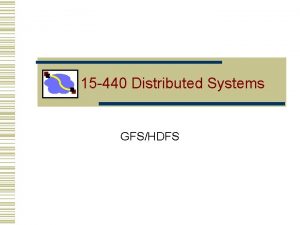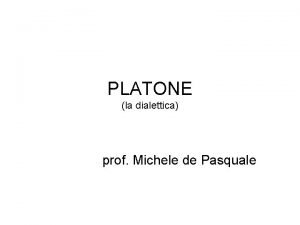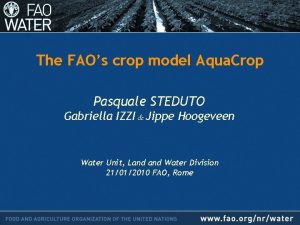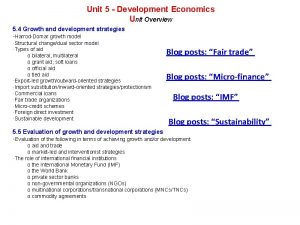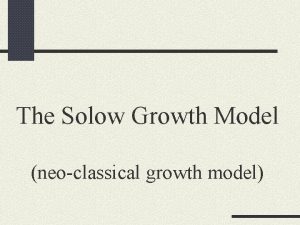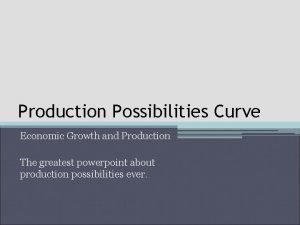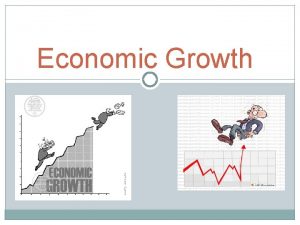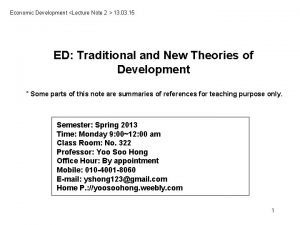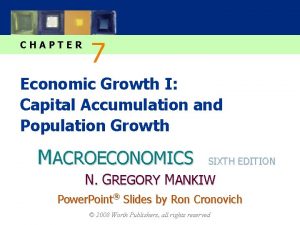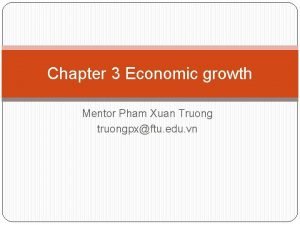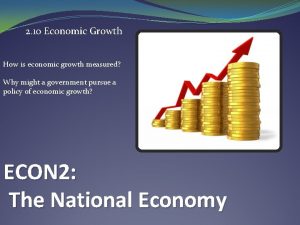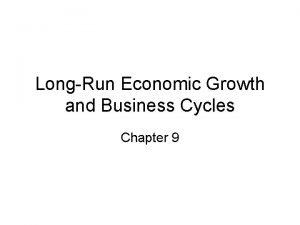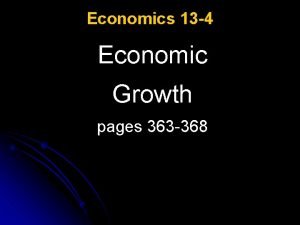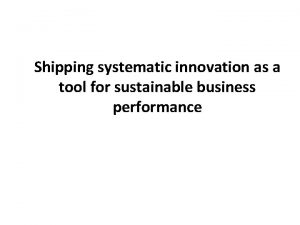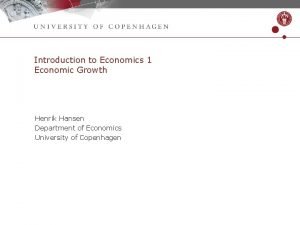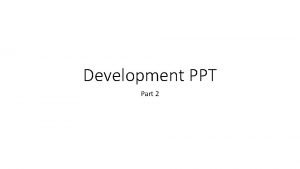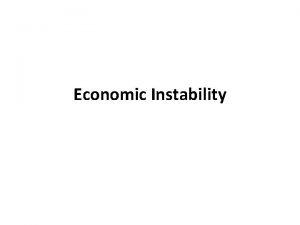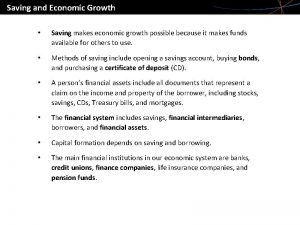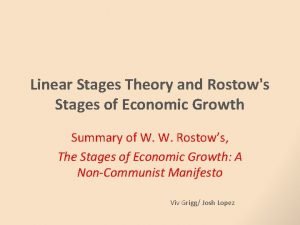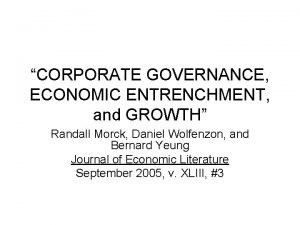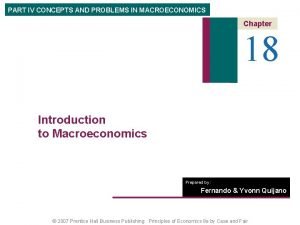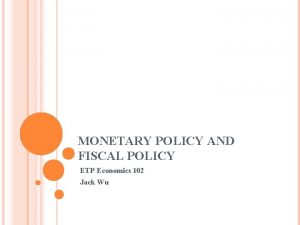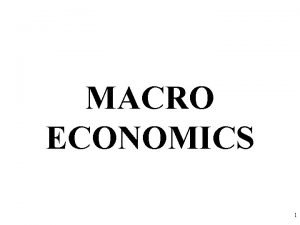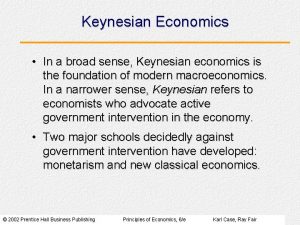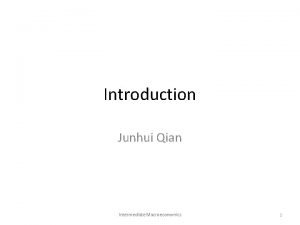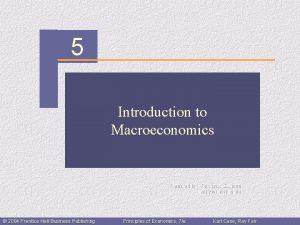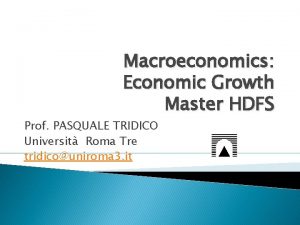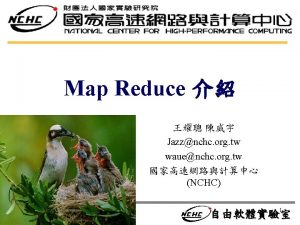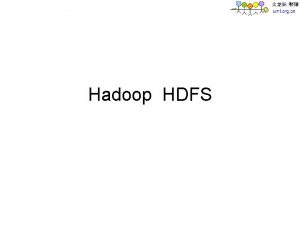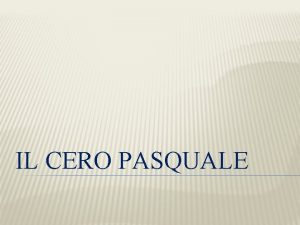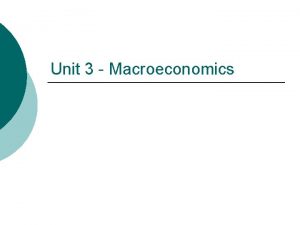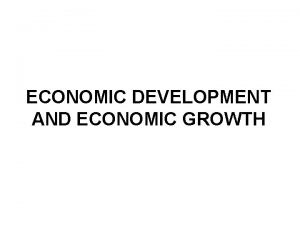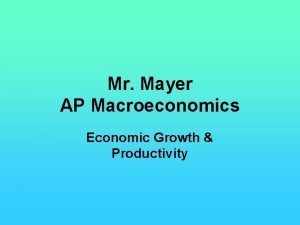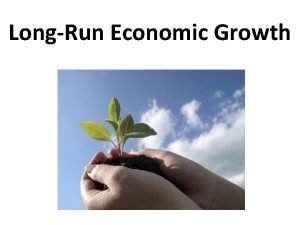Macroeconomics Economic Growth Master HDFS Prof PASQUALE TRIDICO





































































- Slides: 69

Macroeconomics: Economic Growth Master HDFS Prof. PASQUALE TRIDICO Università Roma Tre tridico@uniroma 3. it

Institutions and economic development Main articles Acemouglu et al. , 2001 Rodrik et al. , 2004

Acemouglu et al. , 2001 Differences in European mortality rates to estimate the effect of institutions on economic performance. Europeans adopted very different colonization policies in different colonies, with different associated institutions. In places where Europeans faced high mortality rates, they could not settle and were more likely to set up extractive institutions. These institutions persisted to the present. Exploiting differences in European mortality rates as an instrument for current institutions, to estimate large effects of institutions on income per capita.

The Acemouglu model



All of development economics … on one page Rodrik et al, 2004 income endogenous endowments partly endogenous exogenous productivity trade geography institutions Central question of development economics: which are the most important arrows and why? 7

The recent debate on institutions There has been burgeoning literature within economics that discusses and analyses institutions (see North 1990; Nugent and Lin 1996; Nelson and Winter 1982; Jones and Hall 1998; Olson et al. 1998; Robinson et al. 2001; Glaeser et al. 2004; Bardhan 2005; Hodgson, 2007). Acemouglu et al. , 2001 Rodrik et al. , 2004 The attention of international organisations and policy makers has focused more on the importance of institutions for economic growth. Institutional economists, economic research centres and international organisations have built indexes of governance which measure an institutional quality of developing and advanced countries.

Institutions and development The importance of institutions in the economy and on the economic development is recognized from nearly all the economists who worked on LDCs (Lewis, 1955; Myrdal 1968; Kutznets 1973; Sen 1981; Hirschman, 1990; Solow 1994). However the institutional economics remains too much often outside from the analysis of the neoclassical economic paradigm and from the greater part of the text books, where the neoclassical assumptions (perfect information, zero costs of transaction, profit maximizing etc) prevents whichever debate on the role of institutions in the economics.

Endogenous growth theory Also the recent contributions of the endogenous growth theory (Romer 1986, Lucas 1988), take into consideration elements (such as increasing return to scale, human capital, externalities) whose origins it is not difficult to make to go back to the economic relations that are settled down between the agents, and therefore to the institutions.

SOLOW RESIDUAL (1956) Y- r. K /Y * K - w. L /Y * L= SOLOW RESIDUAL= TFP SOLOW RESIDUAL IS A BLACK BOX WHICH CAN BE EXPLAINED WITH INSTITUTIONS

Questions concerning institutions role The role of the institutions in the economy; Existence of different institutions; The contribution of institutions on the productivity; The existence of inefficient institutions; The mechanisms of the institutional change

Things we should have a look at Religion (religiousness)? Cultural issues? Freedom? Anything else… 13

Religion and religiousness Religion and Economic Growth Across Countries (Barro & Mc. Leary) Motivations of the study: previous studies neglect the influence of culture need for incorporation of social and political variables investigated the effects of church attendance and religious beliefs on economic growth Also in Europe: east orthodoxy vs west catholic/protestant 14

Religion and religiousness Theoretical foundations Secularization hypothesis Market or supply side forces hypothesis greater state regulation of religion may decrease the efficiency Data: World Value Survey, Gallup Millenium Survey, International Social Survey Programme Findings: For given religous belief, increases in church attendance tend to lower growth 15

Cultural issues The theory of human development: A crosscultural analysis (C. Welzel, R. Inglehart, H-D. Klingemann) Foundations Socioeconomic development, emancipative value change and democratization Emancipative values linked to people’s available resources Effective democracy linked to emancipative mass values 16

Freedom? Individuals have economic freedom when: property is protected no arrangements that restrain the realization of gains from economic activities Sources of data: Heritage Foundation/Wall street Journal (10 elements) Fraser Institute (17 elements) Issues to be addressed: Lack of sensitivity analysis Link between economic freedom and economic growth depends on the measure used No studies found that economic freedom does not influence growth 17

Questions People say:“institutions matter. ” Great! But, if institutions are nothing more than codified laws, organizations and other such explicit, intentional devices, why can’t badlyperforming economies design (emulate) “good” institutions and implement them? because they do not change so easily. . . and they are informal… How do institutions change? “history matters” for development. 18

Institutions: a difficult definition Moreover the definition of institution and the effects that them can cause on development are not equally shared by economists. The same definition of economic institutions is often contrasting and it varies according to the various schools of economic thoughts and the various theoretical approaches.

Old Institutional Economy 1. The Old Institutional Economy (OIE) rejects the concept of a rational individual (methodological individualism) who maximises his own benefit and emphasises the role of the habits, behavioural rules and social rules as the basis of the human action. The OIE develops an alternative concept of economic behaviour that finds its own origins in the institutions. The institutions are the rules according to which enterprises and consumers “satisfy” and not “maximise” respectively their own return and utility. For this institutional approach of economics “institutions matter. ” The institutions are not necessarily created to be socially and economically efficient; conversely they are created to serve and to preserve the interests of some social clusters and to create new rules. Institutions, therefore, can be said to be efficient as long as they are committed to their original aims.

New Institutional Economics 2. The second approach is the New Institutional Economics (NEI). Libecap (1998) claims that “the new institutional economics retains its general attachment to neoclassical economics with its emphasis on individual maximization and marginal analysis, but with attention to transaction costs, information problems, and bounded rationality” According to North “the institutions (. . . ) represent the way through which economies face the Market failures. ” Nevertheless, North rejects the assumption of efficient institution and he highlights the vital role of power clusters and lobbies upon the institutional agreements. The most important role of Institutions is that of reducing the uncertainty in order to determine a steady framework of social relations.

the neoclassical theory 3. Finally, in the pure paradigm of the neoclassical theory there is no allocation mechanism different than the market. The only institution admitted is the market where the price is determined. This allocation does not involves equity, norms or behaviour, cultural differences and the institutions are exogenously given, i. e. they are not involved in the economic analysis. In the neoclassical theory with perfect information the allocation is price-guided, the transaction cost is zero. Hence, the institutions (apart from the market) are not useful, instead they inhibit the economic performance.

CENTRAL DILEMMA The main problem in the institutional economic analysis is to establish what is the fundamental paradigm of the economic choices between the two:

NEI and OIE The NEI seems to be oriented towards the 1° paradigm, on the contrary the OIE towards the 2°. In the 1° case the neoclassical approach, although revised, can still work, through the introduction of transaction costs that eliminate negative externalities (Coase 1937). On the contrary, in 2° the case, economic institutions are rules and behavioral patters that not only create the preferences but also abolish the maximizing mechanism, replacing it with a model where agents are not guided by prices but their actions are determined by institutions (Matzner 1993).

Transaction Costs Transaction costs are the costs to make an exchange, to transfer the propriety, to start an activity, to protect one’s own business, to gather information, to change or to preserve the actual institutional framework, etc. Transaction costs, certainly, do not involve only the financial expenses but also time and all resources required to pursuit goals. These resources could be private or public resources and their measure is not only in economic terms but as well in social terms.

NEI position on institutional change The theory of the institutional change in the NEI is based on a fundamental assumption: the institutions reduce the costs of transaction, and the agents would use the institutions in order to diminish the costs of transaction (North 1990). The firms react to the change of the relative prices modifying their productive methods. To the new prices and with the new techniques, old institutions could not be longer suitable to diminish the costs of transaction (North 1990), therefore the institutions will change.

Formal institutions are generally defined as the law sphere, with constitutions, regulations and organisations. There is a direct connection between formal rules and a political economy framework such as governance, property rights, and judiciary system. Thus, reinforcing of the formal institutions is guaranteed by the legal system.

Informal institutions They are a set of social norms, conventions, moral values, religious beliefs, traditions and other behavioural norms that have passed the test of the historical time and that determine the individual behaviour. The informal institutions can be called the Old Ethos or the Carriers of History. These informal rules are part of the dynamic evolution of a community and heritage of its culture. In addition these rules or institutions are selfreinforcing in course of time trough mechanisms such as imitations, traditions and other forms of teaching. They also serve as sanctions that facilitate the selfreinforcing process such as: community membership, fear of expulsion, reputation and fear to be the only one not to respect the rules. There is an inbuilt threat in this Hobbesian type Competition which allows the respect of the rules because otherwise the social relationships will become violent. (Solow R. . 1994)

A normative system This highlights the complexity of a normative system that is characterized by one formal dimension and one informal dimension, each with the own characteristic Hence, Institutions are “a set of social rules that structure social interactions” (Knight, 1992: 2)

A complex framework

Formal/informal Hence it is needed to overcome the distinction between formal institutions and informal ones. Otherwise will prevail a misleading idea, on the effective state of the institutions, whereas there is a change of formal rules with a persistence of previous behavioral patterns (or vice versa) (examples abound. . . ). Both Formal and informal Institutions can determine the behavior of the agents and of the organizations in pursuit their aims.

What is an “institution” then? Arrangements that coordinate the behavior of individuals in society. Institutions are sets of regulatory norms. An institution is a stable, valued, recurring pattern of behavior. 32

Where do we see “institutions”? 11. 1. Is family an institution? 12. 13. 2. Friendship? 14. 3. Love? 15. 4. Marriage? 16. 5. School? 17. 6. Exam? 18. 7. Market? 19. 8. Firm? 20. 9. Contract? 21. 10. Polls (voting) 22. Political party? Constitution? Exchange rate regime? Central bank independence? Currency? Theatre? Literature? Cinematography? Poverty? Social stratification? Casta system in India? ONLY IF…An institution is a stable, valued, recurring pattern of behavior. 33

Example of category of economic institutions Trust Information Property rights and Privatizations Rent-seeking, Groups of pressure and lobbies Bribe/corruption Reputation and Values Mechanisms of selection, Competition and cooperation Intermediary Bureaucracy Organizations Laws and constitutions Industrial relations

There has to be reciprocity The important conclusion Social agents generate, influence and support institutions. BUT Institutions create social agents. A good institution must survive a dual test of “making sense” and “being fit” for its mission. 35

State and Market A concept that must be clarified is that the economic institutions are not external ties that hinder economic growth and do not refer to a contraposition between State and Market. They are on the contrary the mechanism of operation of the economic processes, the modalities of realization of the exchanges (Fadda 1999, p. 98).

Markets require non-market institutions to work well a. Markets are not self-creating i. Property rights ii. Contract enforcement b. Markets are not self-regulating i. Regulatory authorities ii. Correction of market and coordination failures c. Markets are not self-stabilizing i. Monetary, fiscal and currency arrangements d. Markets are not self-legitimating i. Political democracy ii. Social insurance iii. Redistribution 37

Long term economic development forces (Maddison 1995) institutions natural resources demographic development labor supply human capital technological progress structural Changes (consumption, occupation, parity, agriculture etc) international Commerce, channels and international ways of communication

Different "style of Capitalism" Appropriated economic institutions equal for all countries do not exist, but every country has is own "style of Capitalism" (Rodrik 1999)

Washington Consensus revival 1989: Original Washington Consensus 2000: “Augmented” Washington Consensus the previous 10 items, plus: 1. Fiscal discipline 2. Reorientation of public expenditures 3. Tax reform 4. Financial liberalization 5. Unified and competitive exchange rates 6. Trade liberalization 7. Openness to FDI 8. Privatization 9. Deregulation 10. Secure Property Rights 11. Corporate governance 12. Anti-corruption 13. Flexible labor markets 14. WTO agreements 15. Financial codes and standards 16. “Prudent” capital-account opening 17. Non-intermediate exchange rate regimes 18. Independent central banks/inflation targeting 19. Social safety nets 20. Targeted poverty reduction 40

Disappointments of the Washington Consensus Latin America: Only 3 countries have grown faster during the 1990 s than in the 1950 -80 period (and one of those 3 was Argentina!) Countries in transition: Real output below 1990 levels in all but four former socialist economies; poverty rates higher Sub-Saharan Africa: Results remain very disappointing, and far worse than those obtained prior to the late 1970 s Widening income gaps: Frequent and painful financial crises: Mexico, East Asia, Brazil, Russia, Argentina, Turkey. 41

All of development economics … on one page income endogenous endowments partly endogenous exogenous productivity trade geography institutions Central question of development economics: which are the most important arrows and why? 42

Geographical determinists claim that… income endowments productivity 4 1, 2 trade institutions 1: natural resources; soil quality 3 geography 2: public health 3: colonialism, wars, migrations 4: resource curse 43

… trade fundamentalists claim that … income endowments productivity trade geography institutions Integration convergence 44

…. While the institutionalists prefer income endowments productivity trade geography institutions One kind versus many? Where do they come from? 45

Determinants of wealth log yi = µ + α INSi + β INTi + γ GEOi + ε i (1) INSi = f + l INTi + ψ GEOi + v INSi (2) INTi = j + q INSi + ω GEOi + v INTi (3) 46

Some seminal work Frankel and Romer (1999) Hall and Jones (1999) Acemoglu, Johnson, Robinson (2001) Dollar and Kraay (2002) Alcala and Ciccone (2002) Easterly and Levine (2002) 47

Basic implementations into empirics theoretical concept empirical proxy instrument geography distance from equator, mean temperature, etc. -- integration trade/GDP ratio predicted trade share constructed from a bilateral gravity equation (Frankel and Romer, 1999) institutional quality survey of investor perceptions regarding protection of property rights, rule of law, etc. mortality rates among 19 th century European settlers (Acemoglu et al. , 2001) 48

Opennes 49

Distance from equator 50

Rule of Law 51

Growth and distance from Brussels 52

„Reform” and distance from Brussels 53

Voice and accountability and distance from Brussels 54

Control of corruption and distance from Brussels 55

Economic development = institutional change Since "institutions matter" is crucial to implement institutional policies. Hence, the problem is to implement appropriate institutions that bring about economic development. Development is defined by institutional economists as a process of "institutional change and economic growth" (Toye 1995). However, since institutions are "standardised behaviour patterns" then in order to change institutions those behavioural models must change, breaking off old rules, social norms and routines that impeded a development process before (Kuznets, 1965)

Kuznets says “The transformation of an underdeveloped in developed country is not merely the mechanical addition of a stock physical capital: it is a thoroughgoing revolution in the patterns of life and a cardinal change in the relative powers and position of various groups in the population…. The growth…. must overcome the resistance of a whole and complex of established interest and values”. (1965, p. 30):

Variety of trajectories of development

institutional change (OIE) The institutional change is a slow process, and it starts (because institutions are not longer efficient) when the technological or environmental conditions permit for such a change, or the aims of dominant groups support the change or still when power relations among the social groups change

4 paths of Institutional Changes (OIE): 1. Technology formal and informal change new behaviours and habits. 2. By design formal change new behaviours and habits informal change. 3. Change in the values new behaviours and habits informal change formal change. 4. Revolution formal change informal change.

Concluding remarks Institution formation

Variety of institutions The economic institutions vary from country to country, from the various social contexts and they do not have, generally, a model towards which they converge, in the sense that in some contexts some institutions can be present/useful/efficient in others not, and also where they are similar, it is not said that they carry out the same function or they have the same effects (North 1990). Examples abound. . .

Examples Agents reactions to fiscal pressure in Scandinavian countries and in Mediterranean countries Agents reactions to public concessions (for taxi drivers, for shops, for corporation such as notary, layer, solicitors, etc) Cooperation within Italian industrial districts Adverse Selection within silicon valley Hidden agreements (i. e oil cartel etc) Italian dualism, which is an industrial, institutional and behavioral dualism

Appropriate institutions Every country chooses the economic institutions that thinks are more appropriated for the domestic context, considering the numerous differences that can exist within the same economic system (Rodrik 1999). The Italian districts case is just an example and an interpretation of such a diversity of local governance, local development, and networking between economic agents.

Appropriate institutions (2) In the same way the phenomenon of the Italian dualism between north and south shows that those same institutions do not have the same effect (Graziani 1998).

Appropriate institutions (3) Or still, the phenomenon of familiar Capitalism in some countries of the south east Asian show, in other terms, another variety of capitalism dramatically affected by informal rules. (Hirschman, 1990)

Appropriate institutions (4) In Germany or other Asian countries such South Korea and Japan there is a strong link between banks and the firms, a particular institutional framework and a particular partnership between state and market which have allowed the creation of a successful model of development specific with informal rules of those countries (Rodrik 1999).

Appropriate institutions (5) In LDCs strategies of "Imports Substitution" (IS) or of “Exports Promotion" (EP), and all the connected institutions (subsidies to the exports, customs duties, aids of State, credits to the exports, etc) have been working in the same period, in the same countries but not in others although countries were in the same category of LDCs (Meier 2000).

Varieties of capitalism and welfare systems
 Economic growth vs economic development
Economic growth vs economic development Growth and development conclusion
Growth and development conclusion Hdfs caching
Hdfs caching Kubernetes hdfs
Kubernetes hdfs Writable wrappers for java primitives
Writable wrappers for java primitives Namenode hdfs
Namenode hdfs Hdfs
Hdfs Fsck command in hadoop
Fsck command in hadoop Chown -r username
Chown -r username Hdfs transparent encryption
Hdfs transparent encryption Hdfs full form
Hdfs full form Apache marathon latency
Apache marathon latency Gfs vs hdfs
Gfs vs hdfs Frase pasquale
Frase pasquale Frase pasquale
Frase pasquale Danila di pasquale
Danila di pasquale Di pasquale wheaton modell erklärung
Di pasquale wheaton modell erklärung Michele de pasquale
Michele de pasquale Jippe hoogeveen
Jippe hoogeveen Pasquale foglia
Pasquale foglia Dr pasquale casale
Dr pasquale casale Pasquale blasi
Pasquale blasi Pasquale pagano
Pasquale pagano Relative growth rate equation
Relative growth rate equation Monocot vs eudicot
Monocot vs eudicot Growthchain
Growthchain Primary growth and secondary growth in plants
Primary growth and secondary growth in plants Primary growth and secondary growth in plants
Primary growth and secondary growth in plants Geometric exponential growth
Geometric exponential growth Neoclassical growth theory vs. endogenous growth theory
Neoclassical growth theory vs. endogenous growth theory Difference between organic and inorganic growth
Difference between organic and inorganic growth Harrod domar growth model
Harrod domar growth model Justine bouyssou
Justine bouyssou Interest rates and economic growth
Interest rates and economic growth Ppc curve economic growth
Ppc curve economic growth Long run economic growth
Long run economic growth Long run economic growth
Long run economic growth Five stages of economic growth
Five stages of economic growth Solow model of economic growth
Solow model of economic growth Solow model of economic growth
Solow model of economic growth Long run economic growth graph
Long run economic growth graph Factors of economic growth
Factors of economic growth Why is economic growth important
Why is economic growth important Brazil's quest for economic growth
Brazil's quest for economic growth Economic growth is defined as
Economic growth is defined as Economic growth is defined as
Economic growth is defined as Economic growth and development
Economic growth and development Economic growth occurs when
Economic growth occurs when Development
Development Economic growth trends
Economic growth trends Economics chapter 13 vocabulary
Economics chapter 13 vocabulary Saving makes economic growth possible because
Saving makes economic growth possible because Rostows stages of development
Rostows stages of development Corporate governance and economic growth
Corporate governance and economic growth Chapter 1 lesson 2 our economic choices worksheet answers
Chapter 1 lesson 2 our economic choices worksheet answers Example of macroeconomics
Example of macroeconomics Components of macroeconomics
Components of macroeconomics Crowding out effect macroeconomics
Crowding out effect macroeconomics Crowding out effect macroeconomics
Crowding out effect macroeconomics Macroeconomics lesson 2 activity 45
Macroeconomics lesson 2 activity 45 Meaning of managerial economics in simple words
Meaning of managerial economics in simple words Liquidity preference
Liquidity preference Micro economic examples
Micro economic examples What is macroeconomics
What is macroeconomics New classical macroeconomics
New classical macroeconomics New classical macroeconomics
New classical macroeconomics Crowding out effect
Crowding out effect 2012 macroeconomics frq
2012 macroeconomics frq Calculate gdp circular flow diagram
Calculate gdp circular flow diagram Ap macroeconomics-percentage for a 5
Ap macroeconomics-percentage for a 5












